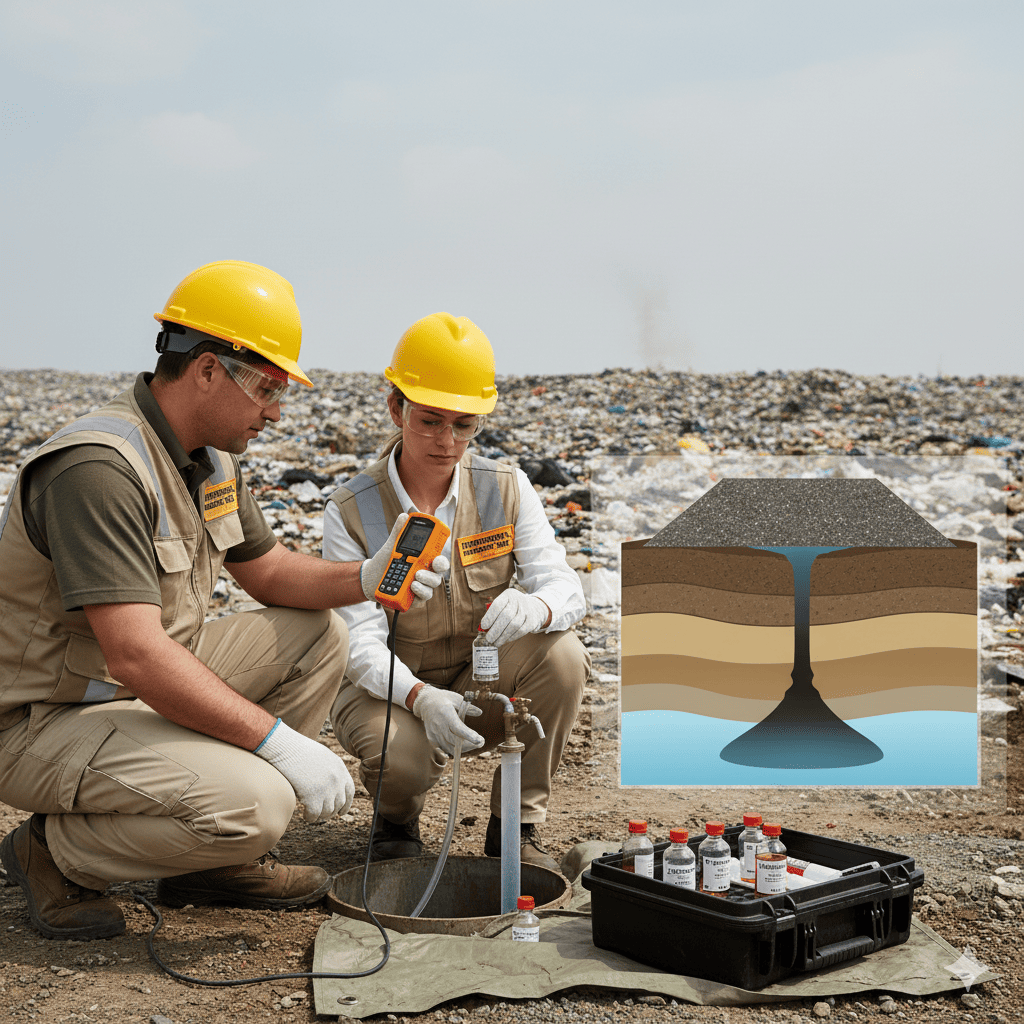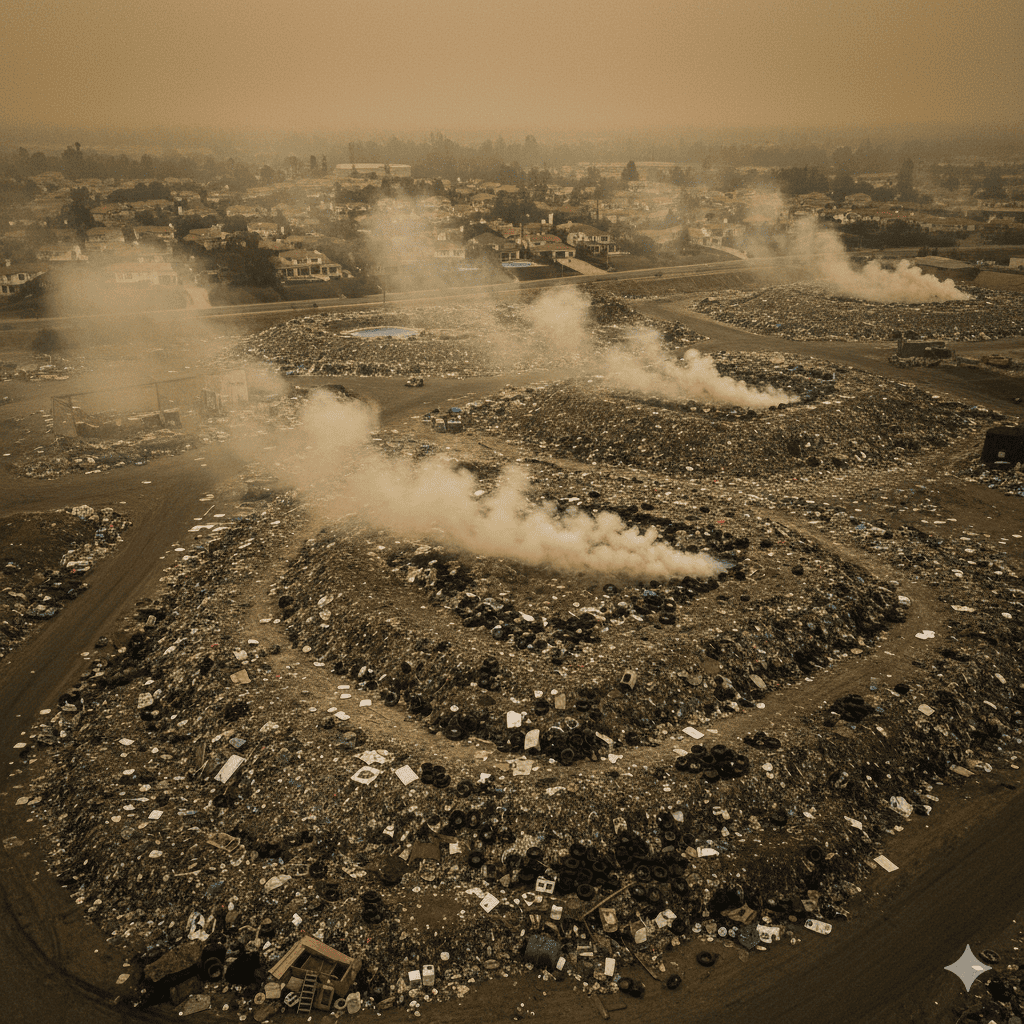Introduction:
The Chiquita Canyon Landfill, a 639-acre waste facility in Castaic, California, has become one of the most watched environmental cases in recent years. A major subsurface thermal event – a chemical reaction occurring deep within a landfill – has raised major health, environmental and regulatory concerns. In response, federal, state and local agencies launched an integrated, coordinated intervention, revealing just how serious the crisis has become and how complicated it is to manage a modern landfill under stress.
The Problem uncovered: odors, reactions and hazardous leachate
The main problem is a long-term underground thermal reaction that started around 2022. This smoldering event has extended deep and wide within the landfill, now affecting a significant portion of the site. The reaction produces noxious odors, leading to thousands of complaints from nearby areas.
The gases released from the Chiquita Canyon Landfill contain volatile chemicals and other pollutants that have caused serious public health problems. Many residents have reported symptoms such as headaches, coughing, eye irritation and difficulty breathing.
The thermal reaction also produces unusually large amounts of leachate – a contaminated liquid that forms when water is filtered through the waste. Testing has found harmful chemicals such as benzene in this leachate, making it potentially dangerous if not properly controlled and treated.
A multi-agency task force take control
Due to the scale of the crisis, federal and state officials formed a Multi-Agency Critical Action Team (MCAT). This team includes:
• US Environmental Protection Agency (EPA)
• California Environmental Protection Agency (CalEPA)
• Department of Toxic Substances Control (DTSC)
• California Air Resources Board (CARB)
• CalRecycle
• Los Angeles Regional Water Quality Control Board
• South Coast Air Quality Management District (SCAQMD)
• Los Angeles County Department of Public Health and Public Works
This multi-agency structure ensures expert oversight from all relevant sectors – air quality, groundwater conservation, hazardous waste and solid waste management.
Federal response: EPA takes strong action
EPA has taken a lead role in responding to immediate threats. It issued a powerful enforcement order requiring the landfill operator to reduce odors, properly manage hazardous leachate and control underground response.
The EPA has also mandated extended environmental monitoring at the landfill. This includes increasing the number of gas wells, improving temperature controls in the reaction zone, expanding air monitoring systems and improving gas collection equipment.
Another key EPA requirement is the installation of a large geomembrane cover, a thick HDPE layer spread over the landfill to seal spills and help stabilize reactions underground. This cover is designed to reduce gas emissions, suppress odors and limit oxygen flow into the reaction zone
State Response: CalEPA and DTSC tighten oversight
At the state level, CalEPA and DTSC issued an imminent and substantial endangerment order against the landfill operator. The order outlines strict corrective measures that must be taken or the operator will risk huge penalties and daily fines.
Key requirements for the state include:
1. Relocation of tank facilities where dangerous leachate is stored.
2. Expand geosynthetic covers of landfills to control emissions and heat.
3. Install a vertical reaction barrier to prevent underground heat from spreading to new areas.
4. Increase environmental monitoring including groundwater, leachate and gas sampling.
5. Submit detailed progress reports to regulators.
Government agencies have warned that non-compliance will result in fines of thousands of dollars per day.
Air quality authorities intensify odor enforcement
The South Coast Air Quality Management District (SCAQMD) has issued hundreds of violation notices due to persistent odor complaints. The agency updated the reduction order, which calls for stronger measures such as:
• Drone based methane monitoring
• Real-time remote monitoring of gas wells
• Daily inspection of the landfill system
• Immediate repair of cracks, openings or damaged parts.
SCAQMD has played an important role in ensuring that the landfill minimizes odors and complies with air pollution regulations. The agency’s work directly reflects the overwhelming number of resident complaints.
Water quality oversight: Protection of groundwater and runoff

Another important agency, the Los Angeles Regional Water Quality Control Board,has tightened oversight of the landfill’s water-related permits. His responsibilities include:
• Control the runoff of stormwater
• Monitor leachate management
• Enforce standards for the protection of groundwater
Given the high levels of contaminants found in leachate, water quality enforcement has become necessary to prevent environmental damage.
Technical and health agencies add support
In addition to EPA, DTSC, and SCAQMD, several other agencies provide technical expertise:
• CARB supports air quality testing.
• OEHHA (Office of Environmental Health Hazard Assessment) evaluates potential health effects from chemical exposure.
• CalRecycle oversees the local enforcement agency (LEA) responsible for solid waste regulations and landfill inspections.
All of these agencies contribute specialized knowledge that helps regulators understand and manage the emerging crisis.
Public engagement and transparency Initiative
Government agencies have attempted to keep the public informed through the following:
• Community meetings
• Public report
• Online updates
• Multi-agency briefing
This effort provides citizens with information about risk, monitoring data and what measures regulators are taking.
At the site, agencies have expanded environmental monitoring stations to monitor air quality and detect hazardous gases. New temperature probes, gas sensors and leachate sampling systems are helping agencies monitor changes deep within the waste mass.
Enforcement: Holding the operators accountable
The operator of the Chiquita Canyon Landfill now faces one of the most stringent sets of requirements ever imposed on a California landfill. These include:
• Order to stabilize the reaction below the surface
• Strict limit for odor reduction
• Mandatory installation of an advanced cover system
• Disposal of hazardous leachate
• Continuous monitoring and reporting
Several agencies have already issued violation and enforcement actions when progress is slow or inadequate.
Long term plans: prevention and possible termination
The supervisory authorities believe that the problem will not be solved quickly. Even if the landfill stops accepting waste, the underground reaction can continue for years before it stabilizes.
Long term plans include:
• Maintain geomembrane cover
• Operation of extended gas collection system
• Monitoring of groundwater and surface water
• Install underground barriers
• Handle leachate safely
There are also discussions about phasing out the landfill based on progress and future risk.
Ongoing challenges and Community concerns
Despite the authorities’ aggressive response, citizens are worried. Odor problems persist, health concerns persist, and pent-up reactions remain unpredictable. Many members of the community believe that the action should have started earlier.
Landfill operators have been criticized for slow prevention efforts, while agencies face pressure to speed up enforcement and increase transparency.
Why the government response matter?
The Chiquita Canyon Landfill case is becoming a national model for handling landfill emergencies. It highlights:
1. The importance of strong public health protection
2. Need for environmental monitoring in real time
3. The value of multi-agency collaboration
4. Risks associated with aging landfill infrastructure
5. The importance of community involvement and transparency
This situation also shows that environmental crises require rapid, science-based responses rooted in accountability and public safety.
Conclusion:
The government’s response to the Chiquita Canyon Landfill crisis is one of the most comprehensive environmental interventions in recent California history. Dozens of federal, state and local agencies have joined forces to stop the subsurface thermal reaction, reduce odors, deal with dangerous leaks and protect nearby communities.
Faced with public health concerns, citizen complaints and years of incomplete mitigation, agencies have strengthened enforcement, expanded monitoring and sought long-term solutions. Although the crisis is far from over, coordinated government action shows a strong commitment to protecting both the environment and the people living near landfills.

